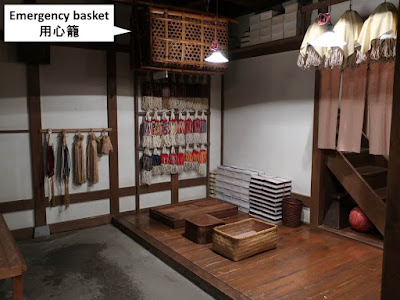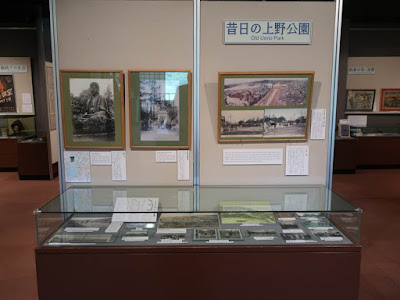This small museum is located in Ueno
Park, Tokyo. Shitamachi means congested city area where ordinary people
live and work. The full-scale model of Ueno town around 1920 was built in the 1st floor,
and Shitamachi culture is exhibited on the 2nd floor. This is an experience
based museum which means that we can go inside the houses and touch the exhibits. I go to
this museum every six weeks as a volunteer guide. I invite foreign
visitors to the living room of the apartment, and say to them "This is so small, isn't it?", but
some foreigners say “Compact is good/cool”.
Talking about fun of old Japanese,
the small space is used well in order to enjoy everyday life. For example,
plant pots are placed on the alley which is also the playground for children. The
exhibitions of annual events such as a star festival in July are so nice. My
favorite exhibit is Doko which can warm sake alcohol properly.
1階は1920年頃の上野を再現した町、2階は下町史料を展示している。体験型で家の中に入り展示物を触れるし、写真撮影は原則可能。私は、一月半に一度のペースで、こちらのボランティアガイドをしています。外国の人と日本の長屋の中に入ると、“ここで、一家族が生活していたの!”→“狭いでしょう”→“コンパクトな暮らしはクールです”などと会話が盛り上がります。
人の楽しみの面からみると、狭い路地を庭にし、子供の遊び場にして生活を楽しんでいるのはクールだし、祭りや七夕などのイベント展示も楽しい。個人的には、ドウコという独特の湯沸し器具を気に入ってます。
Cars were not popular back then, while carts were
major. The cart in front is “Hako-guruma” which was used to deliver beautiful products
such as kimono fabrics. Next one is a very popular cart called “Daihachi-guruma”
which was used to deliver material such as fibers or rice. The last one is an
old style taxi “rickshaw” which was called “Jin-riki-sha, 人力車”.
The rickshaw was invented in Japan around
1870. At that time, Japan imported almost everything, for example, industrial
products, political systems and educational systems from Western countries such
as UK, Germany and France. However the rickshaw was originated in Japan and it
was spread to Asian countries such as China, Thailand and Singapore, so I am
proud of it. By the way, the origin of a word “rickshaw” is “riki-sha, 力車” which is Japanese.
 |
| Rickshaw |
人力車は1870年頃に日本で発明され、アジアに広がった。人力車の英語、”Rickshaw”の語源は“力車:Rikisya”。文明開化で何でもかんでも輸入していた中での日本の発明品だ。
At that time, shops faced to main streets, and
there were apartment houses for ordinary people behind the shops.
There is a shop curtain which is hung when the shop opens. This shop is a wholesaler of Hanao shoe(Japanese sandal, Geta) straps.
開店中は暖簾が出ているのです、と説明する。鼻緒屋さんです。
At the negotiation space, master sat behind the lattice and customers
sat on the Zabuton cushions. They had business talk here. There are a charm cat
and a Kumade rake which are ornaments to invite customers and money. Charm cat
is well-known in Asia because many Japanese restaurants in Asia place it at
their entrances. There are sliding doors with glass which only wealth families
can equip.
 |
| Entrance of the shop、表通りの商店の入口 |
 |
| Negotiation space、商談場所 |
ネゴシエーションスペースと説明。お客さんが座る場所、店主が座る場所を説明し、腰かけながら、招き猫、熊手を説明して、ガラスの入った高級な障子を説明します。これは、後程、長屋の紙だけの障子を説明する前振りです。
There are material and working desks at the
manufacturing area. An emergency basket called Youjin-kago is hung which is used
in the case of fire to bring valuables and necessities. Japanese houses were
made from wood and paper, so fire spread very fast. Fire fighters destroyed
houses in order to stop the fire, while people run away quickly.
 |
| Manufacturing area、作業スペース |
天井から吊っているのは用心籠で、火事の時に貴重品と必需品を入れて持ち出す。火事の時に家を壊すという発想がないせいか、回答できる外国人は少ない。
Next photo shows a view of the entrance from
inside the store. There are sliding doors (up and down) in order to keep the
wide width of the entrance.
There is a well in front of the apartment
houses where women and children gathered and chatted. The communication is
called “Ido-bata-kaigi” which means “a meeting by a well”, it is similar to “Water
cooler conversation”. The washboard was invented in Germany and those were
popular in Japan at that time. They needed a lot of time for washing, but it
brought people enough time to talk together. By the way, the ground water of
Tokyo is salty, so the water was induced from the river which is 43km away. The
wood were used as channels mainly, I feel our wooden culture.
女性と子供が集まる場所である。東京の地下水は塩辛いため43km離れた多摩川の取水口から水を持ってきた。木の樋を使ったのが、木文化の日本らしい。この時期には東京の水道工事が進んでいる。ちなみに、洗濯板はドイツの発明品である。
Washed fabrics are exhibited on the alley
between apartment houses. Japanese kimono was untied to pieces every two or
three years in order to wash completely and to be stretched using laundry glue,
then dried on the board. It is called “Arai-bari 洗い張り”. When the fabric became older, it was used for the kimono of
children or elderly people. The fabric was transformed to dust clothes or
diapers finally. The spirit of reuse or Mottainai policy (http://www.greenbeltmovement.org/what-we-do/advocacy/mottainai-campaign) is seen here.
Green plants are placed in the alley, because
the alley is a garden for the people in the congested city area. The prices of
plants were fluctuated at that time, thus those were kinds of investment. Birds
are placed in the alley too which were also investments. I saw a white-eye bird
competition and auction when I was a child. It was a time without various
entertainments, so people cherished plants and birds I think. In addition, the
alley was the space to hang out peels which were used as medicine and mosquito
incense. Moreover, the alley was a playground for children, I did hide-and-seek
when I was a pupil.
路地。洗い張りが展示されている。着物をほどいて、洗って、張って、縫い直す。古くなれば老人用や子供用の服にする。最後は、雑巾やおしめにする。リユースの精神に感心する外国人が多い。
路地裏では、植木が置かれていて、住民の庭になっている。植木には相場があり、高く売れることもあったそうな。投資でもある。鳥も飼っている。鳥も投資対象で、私が小さいころ、メジロの鳴き比べなどをしていた。TVゲームがなかったころ、ペットが遊びの対象であり、投資の対象でもあったようだ。路地は、薬や線香代わりになる陳皮を干す場所でもあったし、子供たちの遊び場でもあった。
This is the entrance of the typical apartment
for a family, which is 2.7m width and 3.6m long. Foreign visitors ask me “How
many people live here?” The answer is 1 to 6 people. This is a candy shop and 2
people lived.
駄菓子屋である。9尺2間、2.7m×3.6mが庶民の住処となるが、何人住んでいたのか、など、西洋人にはビックリのスペースになる。
Right side of the entrance is a
kitchen space. There is a storage space under the floor. There is a sliding
roof which exhausts smoke, and the God of the fire is placed. We don’t use a
chimney.
玄関の右側は台所。右下は、いわゆる座り流しというシンク。叩きの下は収納スペースになっているが、外国人は驚く。台所の上は、移動式の天井。排気口となる。煙突はない。そして、火の神様を祀っている。
There is a family shrine in this small
apartment, so there are two gods (fire and family) here. I think we Japanese respect
Gods so much.
There are only two rooms in this apartment and one room is used as a candy shop. So this room is used as a dining room, living room and bed room. It is a multi-use room
which supports our compact life style.(We didn't use chairs) The dresser and the sewing box are so
small which seems to be girls toys.
By the way, the texture of tatami
mats are very cozy, I can say all Japanese are fond of tatami mats.
この部屋は、食堂であり、居間であり、寝室である。当たり前だが、マルチユースな部屋に驚く外国人も多い。化粧台とお針箱の小ささには、まず驚く。狭いでしょ、というと、コンパクトなのはクールだという外国人が多い。ちなみに、ちゃぶ台は、西洋文化の影響を受けており、明治時代以降のもので、以前は箱膳を使っていた。畳は心地よい。
There are sliding doors without
glass and a toilet which is not a flush toilet.
Next tenant is for a copper-smith who lived with a
wife and two children. He renovated his apartment for his work shop. In the living
room, Doko is in the stove and boils the water of the pot. It also warms the
sake alcohol bottles. It’s really cool, but I cannot buy Doko today because an
old style stove in which we can place Doko disappeared today.
長屋のお隣は、鍛冶屋さん、4人が住んでいる設定です。居間には、長火鉢、ドウコと呼ばれる湯沸し器具が載っている。お酒を燗できる機能もついている。素敵だが、火鉢を使わない今は売っていない。
There is a small Inari shrine on the alley.
Inari god, who is the god of the agriculture, is very popular among ordinary
people because Inari god is believed to bring us prosperity and happiness. Messengers
of Inari god are foxes, and foxes like fried tofu so we offer fried tofu to
Inari god. If you visit Japan, you will find Inari noddle and Inari sushi
whose ingredients are fried tofu. You can try Omikuji fortune slip here.
路地のお稲荷さん。農業の神であるお稲荷さんは繁栄につながりお地蔵さんとともに人気があること、稲荷寿司、きつねうどんのいわれ等を説明する。二月には、初午のお祭りをする。
路地のお稲荷さん。農業の神であるお稲荷さんは繁栄につながりお地蔵さんとともに人気があること、稲荷寿司、きつねうどんのいわれ等を説明する。二月には、初午のお祭りをする。
On the second floor, old toys are exhibited
such as dolls and games. You can enjoy playing with old wooden toys.
The photo below is the front desk of the
public bathhouse which was praised by foreigners. It was written on the fryer
of Osaka museum of Housing and Living, “The Japanese are a bath-loving
people.” and “bathhouses are magnificent recreation centers (for Japanese) ---
Japanese bathhouses are an effective combination of physical hygiene, mental
health, socializing, and recreation” (R. Alcock,the 1st British
Consul-General). Big bath is fun.
銭湯の番台。資料館最大の展示物だ。よくぞ残していてくれた。大阪くらしの今昔館の英語パンフレットに、「日本人は風呂好きだ。(中略)日本の風呂屋は、公衆衛生、メンタルヘルス、近所付き合い、リクレーションの効果的なコンビネーションだ」と英国領事が書き残している。風呂は楽しみだ。
The apartment at 1960s is exhibited, it was a
time I was born. Our society changed fast then, so there are many appliances in
this room such as TV, sewing machine and radio.
昭和三十年代、私が生まれたころの庶民の家。急速に、生活が電化され変わっていた時だ。室内には電化製品が沢山。こんなに電化製品があった家はない、というが、私はこんなイメージだ。
昭和三十年代、私が生まれたころの庶民の家。急速に、生活が電化され変わっていた時だ。室内には電化製品が沢山。こんなに電化製品があった家はない、というが、私はこんなイメージだ。
 |
| Exhibits of everyday goods in the Showa period (1926-1989) 昭和時代の展示品 |
 |
| Goods in summer such as mosquito coil、蚊取線香など夏の虫取り道具 |
 |
| Special exhibition “Old Ueno Park”、特別展・昔日の上野公園 |
 |
| Shitamachi Museum、資料館外観 |
 |
Shinobazu pond with many water lilies which is in front of the museum、蓮に覆われた資料館前の不忍池
|
 |
| Ameyoko shopping street which is 5 minute walk from the museum、アメ横 |
8 funs(楽Fun) were found. Visited in September, 2018
http://www.taitocity.net/zaidan/english/shitamachi/, accessed in Decmber, 2018
Reference:
Previous post (about Edo city) : Fukagawa
Edo museum 江東区深川江戸資料館
Next post (about craft's work in the Edo period) : Gallery
of Edo Shitamachi Traditional Crafts 江戸下町伝統工芸館
【Rev1(Additional)、改訂一版(記事追加)】
Special exhibition of the Edo period style dolls, from 7th
of December to 24th of February.
特別展『「江戸風俗人形」の世界 〜建物・人形・小物の三位一体の妙〜』、2019年12月7日~2020年2月24日
Three artists, including
Jusaburo Tsujimura (Doll creator), produced a really exquisite model of the
Girou house at Yoshiwara which was an authorized red-light district near this
museum. It was exhibited together with historical documents and pictures. The
old-time beauty of ladies (their photos are prohibited) was attractive.
 |
The parade of ladies, who are receiving a customer, passes in front
of the Girou house.
遊女達が茶屋からお客さんを迎えてくる、いわゆる花魁行列が廓の前を歩いている。
|
人形の辻村寿三郎ら三名の作家が、約一坪の展示台の上に作った吉原の妓楼の模型を展示している。吉原遊郭はこの資料館から遠くない場所にあった。細部まで精巧にできており、古文書や写真(絵はがき)とともに展示された。花魁たちの写真(撮影禁止)も有り、昔風の美しさにびっくり。
 |
The Oiran lady’s guest room which is coordinated as summer style
花魁がいる部屋:夏のしつらえの客間
|
 |
The lady taking a break? (summer style room)
休憩中?の女性:夏のしつらえの間
|
 |
The lady writing a letter; invitation letters were very important for
ladies. (spring style room)、手紙を書く遊女:春のしつらえの間、お客さんに手紙を書いて来店を促すのは、花魁達の大切な仕事の一つ
|
 |
The lady grooming herself (spring style room)
身なりを整える女性:春のしつらえの間
|
 |
There are a table with a stove and miniature furniture in a winter
style room. 冬のしつらえの部屋には、コタツと精巧に作られた家具
|
 |
Yoshiwara district in the early 20th century (inside the
red square).
大正時代の吉原全景(赤枠の内)
|
 |
| Postcard of the Girou house、絵葉書になった妓楼 |
 |
| Sakura cherry blossoms in Yoshiwara int the early 20th century |
Reference、参考:The
Great Yoshiwara 吉原はスゴイ (published in 2018)

























Comments
Post a Comment